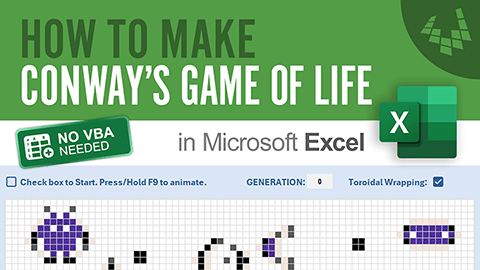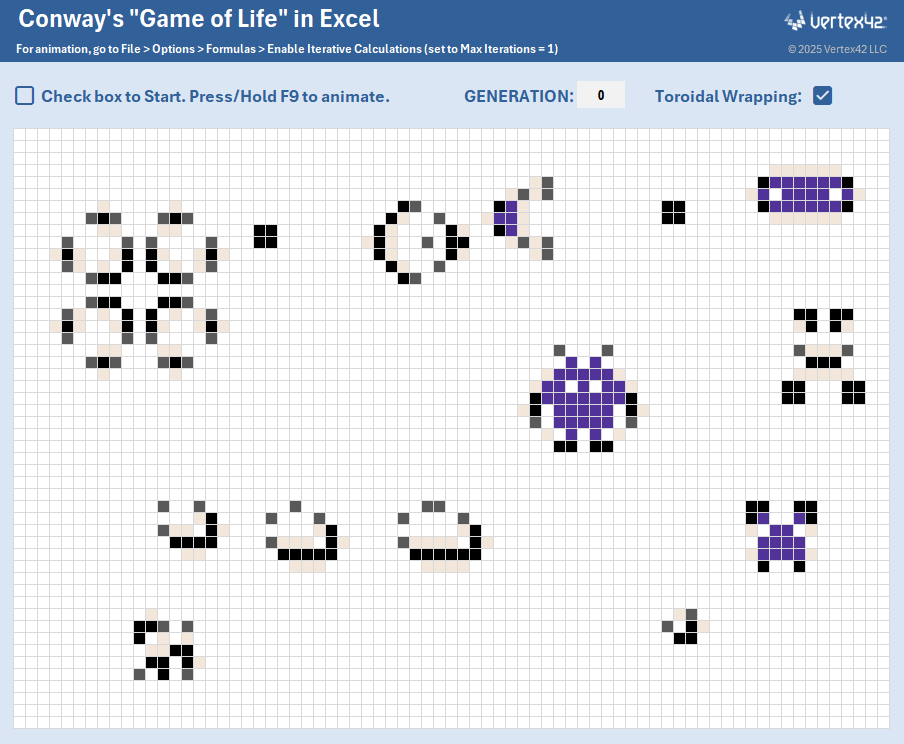Game of Life - Animation in Excel
John Conway's "Game of Life" is one of the most famous examples of how simple mathematical rules can produce complex, lifelike behavior.
This Excel version lets you simulate the Game of Life without any VBA code — using only formulas, circular references, and iterative calculation. Download it to explore how patterns grow, move, and evolve right inside a spreadsheet.
Make Conway's Game of Life in Excel
Watch the video to see how to build and animate Conway's Game of Life in Excel without VBA.

You'll also see a clever technique for creating spreadsheet animations using Excel's built-in iterative calculation feature. Teachers, engineers, and students can use this model to explore cellular automata, iterative computation, and Excel simulation techniques.
Download the Game of Life Template
in ExcelDownload
⤓ Excel (.xlsx)License: Private Use (not for distribution or resale)
Description
Play Conway's GAME OF LIFE in Excel without VBA. This requires you to enable iterative calculations in a specific way. Go to File > Options > Formulas > Enable Iterative Calculations, and set the Maximum Iterations to 1. Then check the box to start the simulation and press or hold F9 to animate.
This template shows more color than you would typically see (normally only black and white cells). I added color to show which cells are going to come alive (light tan) or going to die (dark gray - underpopulation, and purple - overcrowding).
Before running the simulation, you should close all other open Excel files. This will help speed up the simulation and prevent things like Data Tables from causing additional iterations.
How it Works
This simulation uses a synchronous, Jacobi-style iteration (use old values, then replace), where the update represents one forward step (the next generation). Array_next is calculated from Array_current and then Array_current is replaced by Array_next to begin the next step.
- Seed: Begin with an initial grid ("seed") of 0s and 1s, representing dead(0) and live(1) cells.
- Current Generation: Start the simulation with the seed grid.
- Count Neighbors: For each cell, SUM the eight surrounding cells to find how many neighbors are alive.
- Apply the 4 Rules to Calculate the Next Generation:
- A dead cell with exactly 3 neighbors becomes alive (reproduction)
- A live cell with fewer than 2 neighbors dies (underpopulation)
- A live cell with more than 3 neighbors dies (overpopulation)
- A live cell with 2 or 3 neighbors lives on
- Update Current Generation: Replace the old grid with the new one, and return to step 3.
This single formula expresses the core logic to calculate the next generation in step 4:
=LET(s,state,n,neighbors, IF(s=0, IF(n=3,1,0), IF(OR(n=2,n=3),1,0) ))
Toroidal Wrapping (Infinite Grid Approximation)
The Game of Life is defined on an infinite grid. In Excel, we can approximate this by wrapping the edges — meaning cells on one edge treat the opposite edge as adjacent. This creates a "toroidal" or donut-shaped world instead of hard borders.
When counting neighbors near the edges, the formula references opposite-side cells to maintain continuity — as shown in the video demo.
Circular References
Normally, circular references cause errors — but in this model, they're what make the animation possible.
1. Iterative Counter
The generation counter increments itself using a circular reference if the checkbox state is TRUE. Otherwise it is set to 0.
=IF(_checked, self+1, 0)
2. Dynamic Grid Update
The grid formula updates based on the checkbox state as well:
=IF(_checked, _next, _seed)
Each iteration recalculates based on the previous generation's state.
To step the simulation manually, enable iterative calculations (File → Options → Formulas → check Enable Iterative Calculation) and set Maximum Iterations = 1. Then press F9 to advance one generation at a time.
References and Resources
- Conway's Game of Life at Wikipedia - Where I found most of my information and examples.
- Play Game of Life Online - This site also has a description of a lot of the different types of known patterns. Very cool.
- FLIP functions for Excel - This Game of Life template includes the FLIPLR, FLIPUD and ROT_90 functions from the Vertex42 Lambda Library. These are helpful when flipping or rotating your pixel patterns.



